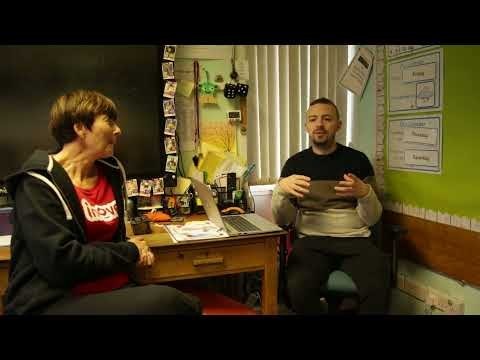Transcript from the video...
How can I create a more active classroom?
So, we're here again in an active classroom, and what we're going to do today is just very, very quickly take you through some really simple tips on how to make your classroom super active.
The first step is by doing some decluttering, moving a bit of furniture which tells the children, “I mean business”, we’ve moved the classroom around a bit and we are going to be active.
So how did you do it?
The first thing that I focused on was getting my desks in the right place. It's really important if you’re going to have an active classroom to make sure that your furniture is in a useful position to enable you to do it. Like, say, if you make the commitment to creating a space to do activities, once you do activity, then you're not giving yourself any excuses. It says to the children that, “This is now my mindset and this is going to be your mindset. Yeah, we are going to be active regularly!”.
I spread out my tables enough to open up a pocket of space that is permanently there that I know I can use, and the children now know that we will be using it regularly. So, whenever we do little brain breaks or little bursts off of the screen, the kids straight away straight into that area because that's the place where the we can be active.
So, first thing, try to get a dedicated space in your classroom or if you don’t have that space, then de-clutter to provide more space for the children to move about in.
And even if your classroom is really tight, and I know some classrooms are really packed for space, you feel like you sardines in a can sometimes and you can't quite get the space. You can always think about different ways that you can create an active area.
So, for example, something that I like to use are balance balls instead of chairs. Yeah, it takes a little bit of getting used to for you as it’s not what you’d expect, but the children will love them and they adjust so quickly. Set the expectations they are to be sat on (and not played with!) and they will just get on with it. It’s a great alternative to using chairs and actually builds the children's core strength. It's actually really good for children who find it difficult to sit still and will just fidget throughout a lesson.
The next big step is to look for ways to get short bursts of activity going through the day. What I mean by that as Nike would say, is just do it!
The benefit of doing a bit of activity, which can be literally two minutes in every two to three hours, is that as long as they elevate the heart rate then you’ll flush all those nasty toxins that build up in their brains which causes lethargy and ‘brain fog’. This is when you start to see results afterwards as the children are able to focus on the next part of the lesson far more effectively, improving their behaviour and their learning.
There are lots of brain break platforms you can use which have short videos you can simply play on your interactive whiteboard and gets the children moving. As long as the classroom is comfortable for it, there’s no prep required and you can literally drop in some activity at any part of the day. Every day we all see that post-lunch lull when the children are tired and can be really lethargic. This is a really useful thing to do to energise them for the rest of the afternoon.
Another thing I do is to use activity cards. These are cards you can get which have activities the children can follow, and I show them the cards and shout out how long I want them to do, may be a minute or maybe 30 seconds. It doesn’t take long but just gets the blood pumping.
It doesn't have to be, you know, running around the park which is a major effort to realistically do every day and with all the best intentions in the world, things just get in the way of this. So instead, keep it in the classroom and keep it at their tables and chairs.
